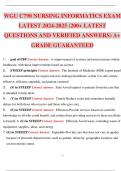WGU C790 NURSING INFORMATICS EXAM LATEST 2024 -2025 ( 200+ LATEST QUESTIONS AND VERIFIED ANSWERS) A+ GRADE GUARANTEED 1. goal of EBP Correct Answer: is improvement of systems and microsystems within healthcare, with these improvements based on science 2. STEEEP principles Correct Answer: The Institute of Medicine (IOM) expert panel issued recommendations for urgent action to redesign healthcare so that it is safe, timely, effective, efficient, equitable, and patient -centered 3. (S) in STEEEP Correct Answer: Safe-Avoid injuries to patients from the care that is intended to help them. 4. (T) in STEEEP Correct Answer: Timely -Reduce waits and sometimes harmful delays for both those who receive and those who give care. 5. (E) in STEEEP Correct Answer: Effective -Provide services based on scientific knowledge to all who could benefit, and refrain fro m providing services to those not likely to benefit. 6. (E) in STEEEP Correct Answer: Efficient -Avoid waste, including waste of equipment, supplies, ideas, and energy. 7. (E) in STEEEP Correct Answer: Equitable -Provide care that does not vary in quality because of personal characteristics such as gender, ethnicity, geographic location, and socioeconomic status. 8. (P) in STEEEP Correct Answer: Patient -centered Provide care that is respectful of and responsive to individual patient preferences, needs, and values, and ensure that patient values guide all clin ical decisions. 9. ACE Star Model of Knowledge Transformation Advancing Research and Clinical Practice through Close Collaboration (ARCC) Model of Evidence -Based Practice in Nursing and Healthcare Johns Hopkins Nursing Evidence -Based Practice Model and Guid elines Iowa Model of Evidence -Based Practice Stetler Model of Research Utilization Correct Answer: FOCUS Correct Answer: EBP, research use, and knowledge transformation processes DESCRIPTION Correct Answer: Direct a systematic approach to synthesizing knowledge and transforming research findings to i mprove patient outcomes and the quality of care Address both individual practitioners and healthcare organizations Focus on increasing the meaningfulness and utility of research findings in clinical decision making 10. Promoting Action on Research Implemen tation in Health Services (PARiHS) Vratny and Shriver Model for Evidence -Based Practice Pettigrew and Whipp Model of Strategic Change Outcomes -Focused Knowledge Translation Determinants of Effective Implementation of Complex Innovations in Organizations Ottawa Model of Research Use Correct Answer: FOCUS Correct Answer: Strategic and organizational change theory to promote uptake and adoption of new knowledge DESCRIPTION Correct Answer: Trace mechanisms by which individual, small group, and organizational contexts affect diffusion, uptake, and adoptio n of new knowledge and innovation Premise is that interventions, outcomes evaluations, and feedback are important methods to promote practice change 11. Collaborative Model for Knowledge Translation between Research and Practice Settings Framework for Tra nslating Evidence into Action Knowledge Transfer and Exchange Canadian Institutes of Health Research Knowledge Translation within the Research Cycle Model or Knowledge Action Model Interactive Systems Framework for Dissemination and Implementation Correct Answer: FOCUS : Knowledge exchange and synthesis for application and inquiry DESCRIPTION : Structure ongoing interactions among practitioners, researchers, policy -
makers, and consumers to facilitate the generation of clinically relevant knowledge and the application of kn owledge in practice All parties are engaged in bidirectional collaboration across the translation continuum 12. Knowledge Transformation Correct Answer: (Ace Star Model) is defined as the conversion of research findings from discovery of primary research results, through a series of stages and forms, to increase the relevance, accessibility, and utility of evidence at the point of care to improve healthcare and health outcomes by way of evidence -based care. 13. Ace Star Model Correct Answer: These five points are discovery research, evidence summary, translation to guidelines, practice integration, and evaluation of process and outcome 14. clinical practice guidelines (CPGs) Correct Answer: The IOM defines clinical guidelines as "systematically developed statements to assist practitioner and patient decisions ab out appropriate health care for specific clinical circumstances. 15. usability Correct Answer: 1.Increased user productivity and efficiency 2.Decreased user errors and increased safety 3.Improved cognitive support 16. human factors Correct Answer: is "the scientific discipline concerned with t he understanding of interactions among humans and other elements of a system, and the profession that applies theory, principles, data and methods to design in order to optimize human well -being and overall system performance." In healthcare, human factors might concern the design of a new operating room to better support teamwork and patient flow. 17. ergonomics Correct Answer: used interchangeably with human factors by the HFES in Europe but in the U.S. and other countries its focus is on human performance with physical cha racteristics of tools, systems, and machines i.e. power drill fitting in hand 18. Human -computer interaction (HCI) Correct Answer: is the study of how people design, implement, and evaluate interactive computer systems in the context of users' tasks and work 19. usability Correct Answer: is often used interchangeably with HCI when the product is a computer but usability also concerns products beyond com puters. Usability is also




